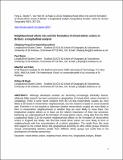Files in this item
Neighbourhood ethnic mix and the formation of mixed-ethnic unions in Britain : a longitudinal analysis
Item metadata
| dc.contributor.author | Feng, Zhiqiang | |
| dc.contributor.author | Van Ham, Maarten | |
| dc.contributor.author | Boyle, Paul Joseph | |
| dc.contributor.author | Raab, Gillian Mary | |
| dc.date.accessioned | 2016-02-28T00:11:33Z | |
| dc.date.available | 2016-02-28T00:11:33Z | |
| dc.date.issued | 2014-02-28 | |
| dc.identifier | 43582137 | |
| dc.identifier | b6968c13-d24f-488b-bd24-425f35a44862 | |
| dc.identifier | 84897662133 | |
| dc.identifier.citation | Feng , Z , Van Ham , M , Boyle , P J & Raab , G M 2014 , ' Neighbourhood ethnic mix and the formation of mixed-ethnic unions in Britain : a longitudinal analysis ' , Geografiska Annaler: Series B, Human Geography , vol. 95 , no. 4 , pp. 307-321 . https://doi.org/10.1111/geob.12027 | en |
| dc.identifier.issn | 1468-0467 | |
| dc.identifier.other | ORCID: /0000-0002-2106-0702/work/64697474 | |
| dc.identifier.uri | https://hdl.handle.net/10023/8328 | |
| dc.description | This research is funded by the ESRC under the Understanding Population Trends and Processes (UPT AP) programme (Award Ref: RE S-163-25-0045). | en |
| dc.description.abstract | Although developed societies are becoming increasingly ethnically diverse, relatively little research has been conducted on geographies of mixed-ethnic unions (married or cohabiting). There is some recent evidence from the US that mixed-ethnic couples are more likely to be found in mixed-ethnic neighbourhoods, but this research is based on cross-sectional data. Therefore it is not possible to determine whether mixed-ethnic couples are more likely to form in mixed-ethnic neighbourhoods or whether they are more likely to move there. Our longitudinal analysis allows us to tease out the relative importance of these two processes, furthering our understanding of the formation of mixed-ethnic unions. Using data from the Office for National Statistics Longitudinal Study we examine neighbourhood effects on the formation of mixed-ethnic unions in England and Wales. We find that mixed-ethnic unions are more likely to form in neighbourhoods with low concentrations of co-ethnic population. The results from this study lend support to the contact theory that geographical proximity to other ethnic groups enhances mutual understanding between people from different ethnic groups and could lead to the development of intimate partnerships. | |
| dc.format.extent | 15 | |
| dc.format.extent | 330866 | |
| dc.language.iso | eng | |
| dc.relation.ispartof | Geografiska Annaler: Series B, Human Geography | en |
| dc.rights | © The authors 2013 Geografiska Annaler: Series B © 2013 Swedish Society for Anthropology and Geography. This is the accepted version of the following article: Feng, Z., Boyle, P., van Ham, M. and Raab, G. M. (2013), Neighbourhood ethnic mix and the formation of mixed-ethnic unions in Britain: a longitudinal analysis. Geografiska Annaler: Series B, Human Geography, 95: 307–321, which has been published in final form at http://dx.doi.org/10.1111/geob.12027 | en |
| dc.subject | Mixed ethnic unions | en |
| dc.subject | Neighbourhoods | en |
| dc.subject | Britain | en |
| dc.subject | Longitudinal analysis | en |
| dc.subject | Union formation | en |
| dc.subject | G Geography (General) | en |
| dc.subject.lcc | G1 | en |
| dc.title | Neighbourhood ethnic mix and the formation of mixed-ethnic unions in Britain : a longitudinal analysis | en |
| dc.type | Journal article | en |
| dc.contributor.sponsor | Economic & Social Research Council | en |
| dc.contributor.institution | University of St Andrews.Geography & Sustainable Development | en |
| dc.contributor.institution | University of St Andrews.School of Geography and Geosciences | en |
| dc.identifier.doi | 10.1111/geob.12027 | |
| dc.description.status | Peer reviewed | en |
| dc.date.embargoedUntil | 2016-02-28 | |
| dc.identifier.grantnumber | RES-163-25-0026 | en |
This item appears in the following Collection(s)
Items in the St Andrews Research Repository are protected by copyright, with all rights reserved, unless otherwise indicated.

